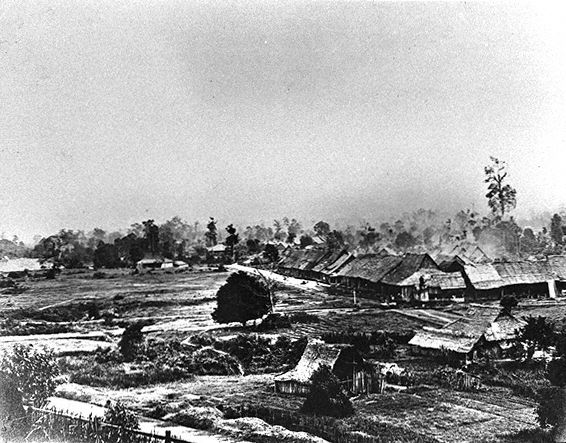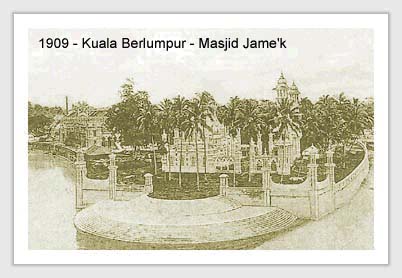Total Pageviews
Friday, 26 August 2011
The Origin of Kuala Lumpur 吉隆坡由來
Most of the people know Kuala Lumpur, the capital of Malaysia, for its Petronas Twin Towers. But not much knows that it's once rich and well known for the tin mining. Merely some knows that the name of Kuala Lumpur actually came from a story related to tin mining.
一般人對吉隆坡的認識都只限於那地標建築物 - 馬來西亞國油雙峰塔。鮮少人知道它曾經是以出產錫礦而聞名全世界,也很少人知道 "吉隆坡" 的地名背後其實是有一個有關採錫礦的故事。
It all began here, the confluence of two river - Gombak River (left) & Klang River (right).
It was back in 19th century when the river banks were germinated with tall coconut trees and thick forest. It's an excellent place for adventurers and the miners, when the news that tin were found at Ampang on the upper river rang the bell. A member of the Selangor Royal family, Raja Abdullah, with the sensitive smell of opportunity and fortune, quickly imported some 87 Chinese from China in 1857 to dig the tine ore.
吉隆坡的起源與由來跟市中心裡的兩條河 - 鵝麥河和巴生河有很大的關係。
It was easy to come in through Klang river by boat. But when it came to the confluence of Gombak River & Klang River, it was too shallow for a boat to pass through, especially when the boat was full with miners. So everyone has to get down and started walking in the mud. If you have the chance to walk in the mud, you will know how hard to just move a step. There's a saying that the name of "Kuala Lumpur" actually came from this incident.
I believe that "Kuala Lumpur" actually means "kuala yang berlumpur", which literally means "muddy rivermouth" and muddy confluence for this situation. Imagine how hard our ancestors had to go up the river to reach Ampang which was around 8km away. Nowadays it only takes about an hour plus by walk to reach Ampang but over one and half century ago our ancestors had to walk in the jungle for many days to reach the destination.
After only two months, only 18 people out of 87 survived. Most of them died of malaria. But this didn't stop Raja Abdullah from gaining his wealth. He got another batch of 150 new miners to keep on the project. With two years of hard work, in 1859 they started to export tin using the same river they got up. It's a business that makes money. More feet stepping into the muddy confluence. Who cares about how dirty it is when it's a road leading to endless wealth?
People moving in and the population started to grow. The boat remained as the main transportation to bring in the flow. The local Malay gathered along the river banks to form a business area called Lebuh Pasar Besar (formerly called Market Street) to sell goods to miners to bring up to the mine. A piece of triangle land on the confluence of the Gombak & Klang rivers which was a Malay cementry was taken up to build a mosque. On 23rd December 1909, the opening of Masjid Jamek by Selangor Sultan Sir Alauddin Sulaiman Shah made it the first large mosque to be built in Kuala Lumpur of that time.
After a long time, from a muddy confluence Kuala Lumpur turned into a blooming city. The development continues and more feet stepping in, just that they are stepping on cement now instead of mud.
Subscribe to:
Post Comments (Atom)





嗨。。。 不知道搞怎么称呼您……
ReplyDelete恩,看到你写了一些关于砂劳越的旅游资讯,觉得很棒……
而在来临的假期,也就是学校假期(十二月),我和几个朋友打算去沙巴背包旅行,不知道博主您有什么好的介绍么?我们打算去差不多一个礼拜…… 应该会走Tawau,sandakan和kota kinabalu 这几个地方走走看看……
我们也上网搜了一艘,会去的几个地方应该会有斗湖国家公园,danum valley,去sepilokl 啦,还有找到鳄鱼园……
不知博主还有什么好介绍么?
哈哈。。。 这边先谢谢博主耐心看完我的问题呀…… 谢谢
你好, 你可以叫我Michael.
ReplyDelete要去沙巴玩基本上主要都是上山下海親近大自然的行程. 先說明, 沙巴很大, 西馬最大的三個州彭亨,霹靂和柔佛加起來也只比它大一點點. 所以說要在短時間到很多不同的地方是不太可能的,除非你搭飛機, 不然建議你可以重點旅遊幾個地方, 不用舟車勞頓.
去斗湖的話我推薦到附近的島嶼如Mabul,Mataking,Kapalai和著名的Sipadan島多過去國家公園.在這些島嶼可以進行浮潛活動, 可以看到很多奇特的魚和海洋生態. 來到這裡一定要品嘗它活潑亂跳的海鮮^^
如果你要去國家公園可以去京那峇魯國家公園, 那裡有很多奇特的蘭花,豬籠草和萊佛士花. 登山遠足後也可以去附近的Poring溫泉紓解疲憊感. 如果你要尋求刺激可以到一段距離外的Padas Water Rafting,絕對會讓你沒齒難忘~
如果你要看Orang Utan的話最好的地方就屬Sepilok生態保護區垃,不過地理位置在Sandakan, 需要從KK或Tawau轉機或轉車去. 這裡也可以看到難得一見的長鼻猴, 還有Turtle Islands及聚考古探險一身的Gomantong Cave, 絕對可以讓你玩得過癮.
你可以上沙巴旅遊的官方網站看看, 那裡有很豐富的資料, 希望對你有幫助.
http://www.sabahtourism.com/tc/